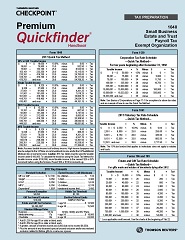
The 2024 Premium Quickfinder Handbook will be available in January 2025. Pre-order your Handbook today.

The Premium Quickfinder Handbook is your trusted source for quick reference to tax principles that apply when preparing individual, business and fiduciary income, estate and gift, tax-exempt organization, and payroll tax returns. It covers the essentials of preparing these tax filings, including detailed, true-to-life examples with filled-in forms and line-by-line explanations, and addresses tax law changes and IRS developments, all in a concise, easy-to-use format.
Whether determining how the tax rules apply to a particular transaction or event, or how to report a particular tax item on the return, or simply looking up an amount or rate, the Handbook gets you the accurate answers you need quickly. Here’s what you’ll get with this useful tool:
See information above for new edition availability. To order the current or prior tax year editions, please call us at 800-431-9025.